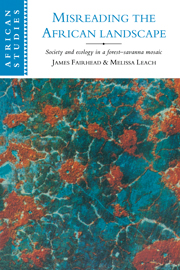Book contents
- Frontmatter
- Contents
- List of plates
- List of figures
- List of tables
- Note on authorship and research collaboration
- Acknowledgements
- Linguistic conventions
- Introduction
- 1 Convictions of forest loss in policy and ecological science
- 2 Forest gain: historical evidence of vegetation change
- 3 Settling a landscape: forest islands in regional social and political history
- 4 Ecology and society in a Kuranko village
- 5 Ecology and society in a Kissi village
- 6 Enriching a landscape: working with ecology and deflecting successions
- 7 Accounting for forest gain: local land use, regional political economy and demography
- 8 Reading forest history backwards: a century of environmental policy
- 9 Sustaining reversed histories: the continual production of views of forest loss
- 10 Towards a new forest–savanna ecology and history
- Appendix I Glossary of plant names
- Appendix II Cassette recordings of oral accounts and discussions
- Notes
- List of references
- Index
- Titles in the series
- Plate section
Introduction
Published online by Cambridge University Press: 05 June 2012
- Frontmatter
- Contents
- List of plates
- List of figures
- List of tables
- Note on authorship and research collaboration
- Acknowledgements
- Linguistic conventions
- Introduction
- 1 Convictions of forest loss in policy and ecological science
- 2 Forest gain: historical evidence of vegetation change
- 3 Settling a landscape: forest islands in regional social and political history
- 4 Ecology and society in a Kuranko village
- 5 Ecology and society in a Kissi village
- 6 Enriching a landscape: working with ecology and deflecting successions
- 7 Accounting for forest gain: local land use, regional political economy and demography
- 8 Reading forest history backwards: a century of environmental policy
- 9 Sustaining reversed histories: the continual production of views of forest loss
- 10 Towards a new forest–savanna ecology and history
- Appendix I Glossary of plant names
- Appendix II Cassette recordings of oral accounts and discussions
- Notes
- List of references
- Index
- Titles in the series
- Plate section
Summary
Kissidougou's landscape is striking. Over open expanses of grassy savanna tower patches of dense, verdant, semi-deciduous rainforest. These forest islands, scattered over the gently rolling hills, are generally circular, perhaps a kilometre or two in diameter, and most conceal at their centre one of the prefecture's 800 or so villages. Apart from these islands, dense forest vegetation is found only in narrow strips along streamsides or swampy valley bottoms. This landscape resembles that in many parts of the West African forest–savanna mosaic or ‘transition’ zone, which stretches along the northern fringe of the forest zone from Sierra Leone eastwards to Nigeria and beyond (figure 0.1).
Since the first French occupation in 1893, Guinée's administrators have been convinced that these forest patches are the last relics of an original dense humid forest which once fully covered the landscape. They suppose that inhabitants have progressively converted this forest into ‘derived’ savanna through their shifting cultivation and fire-setting practices, preserving only the narrow belts of forest around their villages. From the outset, this ‘savannisation’ has been a major policy concern because of the threat it posed to the local agricultural and tree crop economy and to regional climate and hydrology. Today, and with the addition of global environmental concerns, the degraded and degrading landscape of Kissidougou attracts major international funding for environmental rehabilitation. These concerns are not unique to Kissidougou: they have been expressed thoughout much of the transition zone, and elaborated during a century of scientific investigation.
- Type
- Chapter
- Information
- Misreading the African LandscapeSociety and Ecology in a Forest-Savanna Mosaic, pp. 1 - 23Publisher: Cambridge University PressPrint publication year: 1996

